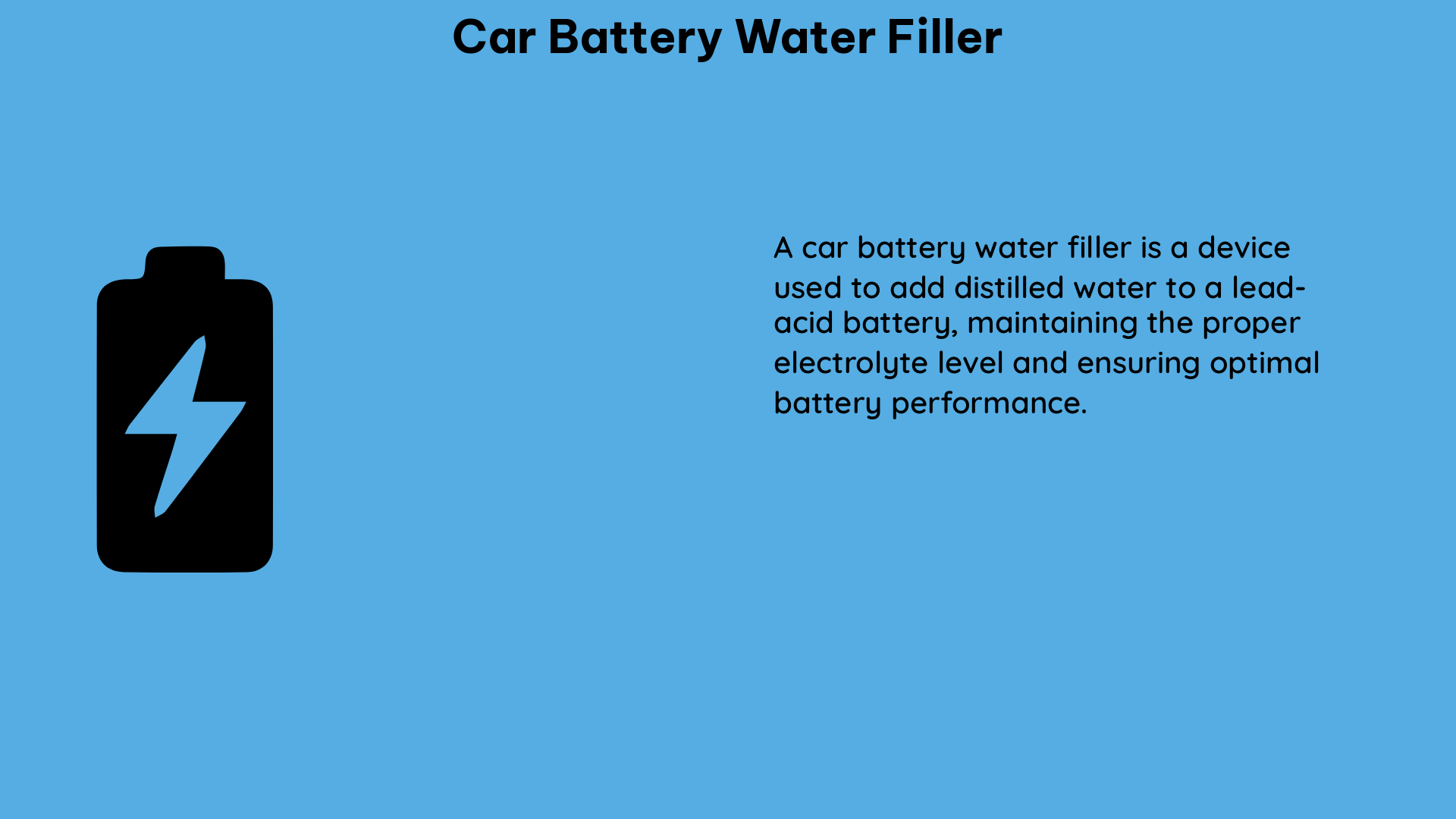Car batteries are the heart of a vehicle’s electrical system, providing the necessary power to start the engine and support various electronic components. Maintaining the proper electrolyte level in these batteries is crucial for their longevity and performance. This comprehensive guide delves into the technical details of car battery water fillers, equipping you with the knowledge to effectively and safely maintain your vehicle’s battery.
Understanding the Importance of Electrolyte Levels
Car batteries typically contain a mixture of sulfuric acid and water, known as the electrolyte. This electrolyte plays a vital role in the chemical reaction that generates electrical energy. The recommended electrolyte level should be enough to cover the plates inside the battery cells. Regularly checking and adjusting the electrolyte level is essential to ensure optimal battery performance and lifespan.
Selecting the Right Car Battery Water Filler

When it comes to adding water to a car battery, using a dedicated battery water filler is highly recommended. These specialized tools are designed to provide a controlled and accurate method of replenishing the electrolyte levels. Let’s explore the key features and specifications of an effective car battery water filler:
Material and Construction
Car battery water fillers are typically made of durable plastic materials, ensuring they can withstand the harsh environment of the battery compartment. The plastic used is often high-density polyethylene (HDPE) or polypropylene (PP), which are known for their resistance to corrosion and chemical exposure.
Capacity and Spout Length
The capacity of a car battery water filler can vary, with common sizes ranging from 8 ounces (237 ml) to 16 ounces (473 ml). The spout length is an important consideration, as it needs to be long enough to reach the bottom of the battery cells, typically around 6 to 12 inches (15 to 30 cm) in length.
Compatibility
Car battery water fillers are designed to be compatible with lead-acid batteries, which are the most common type used in vehicles. It’s essential to ensure that the filler you choose is suitable for the specific make and model of your car’s battery.
Water Type
When adding water to a car battery, it’s crucial to use only distilled or deionized water. Tap water may contain impurities that can harm the battery’s internal components and reduce its performance.
Proper Technique for Adding Water with a Car Battery Water Filler
Using a car battery water filler correctly is essential to avoid overfilling or damaging the battery. Here’s a step-by-step guide to the proper technique:
- Prepare the Filler: Fill the car battery water filler with the appropriate amount of distilled or deionized water.
- Locate the Battery Cells: Identify the individual battery cells, usually accessible through removable caps or vents on the top of the battery.
- Insert the Spout: Carefully insert the filler’s spout into the battery cell, ensuring it reaches the bottom.
- Add Water: Gently press down on the filler to allow the water to flow into the cell. Continue until the water level reaches the recommended mark or until the filler stops gurgling, indicating the cell is full.
- Repeat for Each Cell: Repeat the process for each battery cell, taking care not to overfill or spill any water.
- Secure the Caps: Once all cells have been filled, replace the battery caps or vents securely.
Maintaining Optimal Electrolyte Levels
Regularly checking and maintaining the electrolyte levels in your car battery is crucial for its performance and longevity. Here are some best practices to follow:
- Check Levels Regularly: Inspect the electrolyte levels in your car battery at least once a month, especially after charging or heavy use.
- Add Water Gradually: If the battery appears dry, add distilled or deionized water gradually over several days, rather than filling it all the way at once.
- Avoid Overfilling: Carefully follow the recommended electrolyte level guidelines to prevent overfilling, which can lead to electrolyte overflow and damage to the battery.
- Monitor for Leaks: Regularly inspect the battery for any signs of leaks or corrosion, as these can indicate a more serious issue that requires professional attention.
Conclusion
Maintaining the proper electrolyte levels in your car battery is essential for its performance and longevity. By using a dedicated car battery water filler and following the best practices outlined in this guide, you can ensure your vehicle’s electrical system remains in top condition. Remember, always use distilled or deionized water and avoid overfilling the battery cells to keep your car running smoothly for years to come.
Reference:
- How much water can be safely added to a battery?
- Try filling your battery with distilled water
- Acid Stratification and Surface Charge
- Accurately Adding Water to Batteries
- Accurately Adding Water to Batteries

The lambdageeks.com Core SME Team is a group of experienced subject matter experts from diverse scientific and technical fields including Physics, Chemistry, Technology,Electronics & Electrical Engineering, Automotive, Mechanical Engineering. Our team collaborates to create high-quality, well-researched articles on a wide range of science and technology topics for the lambdageeks.com website.
All Our Senior SME are having more than 7 Years of experience in the respective fields . They are either Working Industry Professionals or assocaited With different Universities. Refer Our Authors Page to get to know About our Core SMEs.